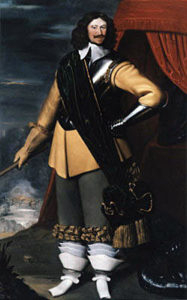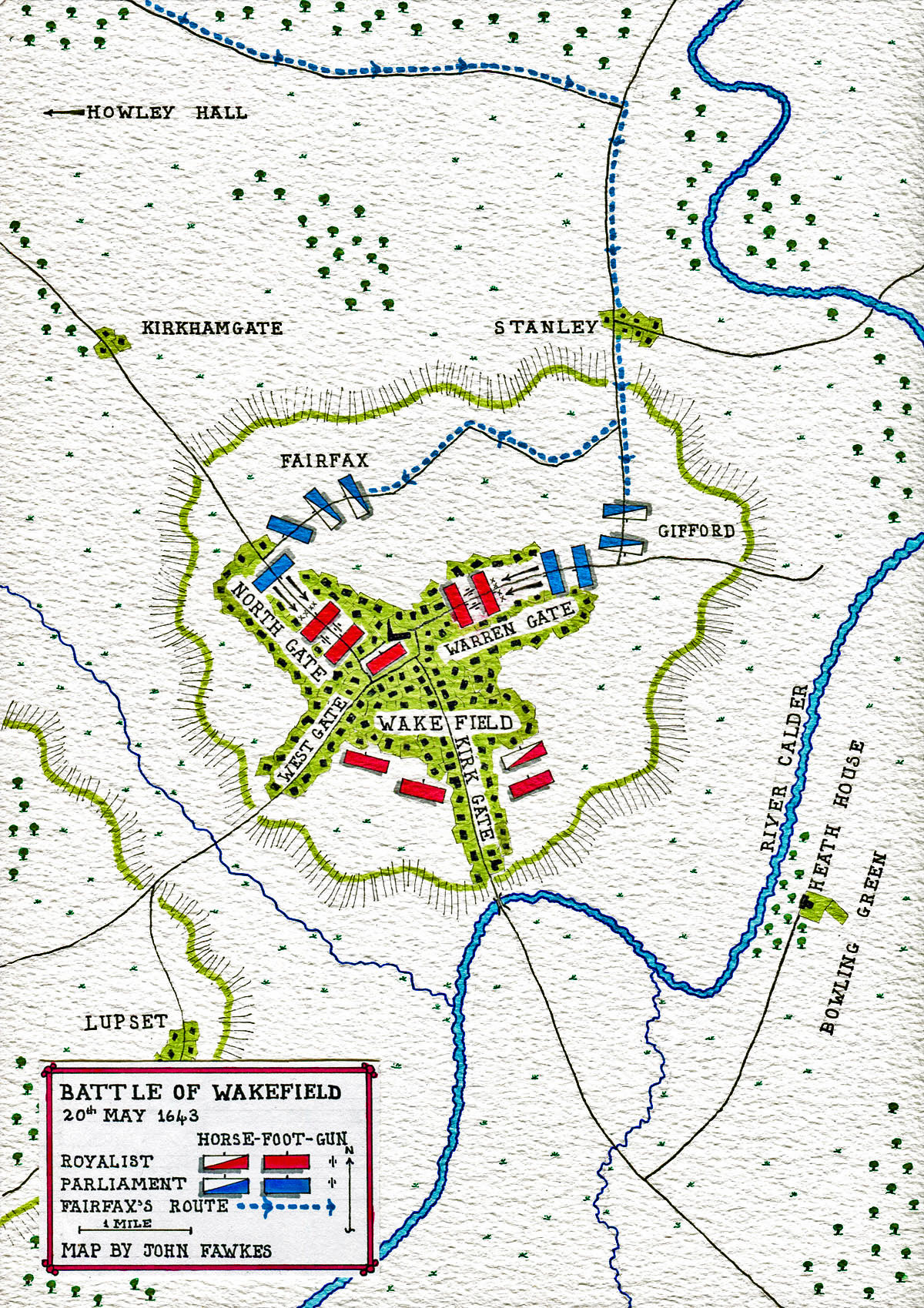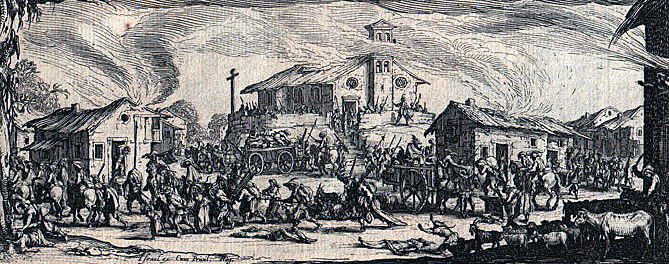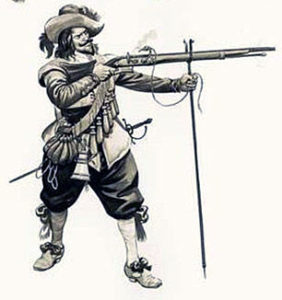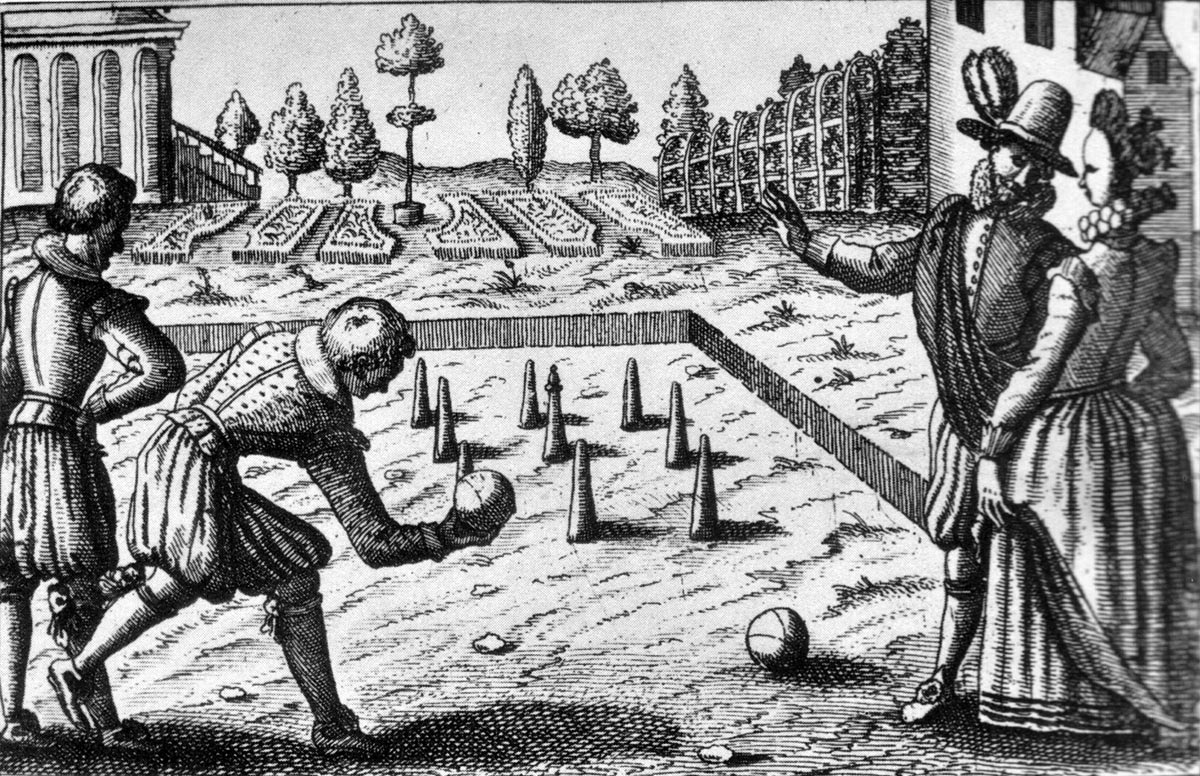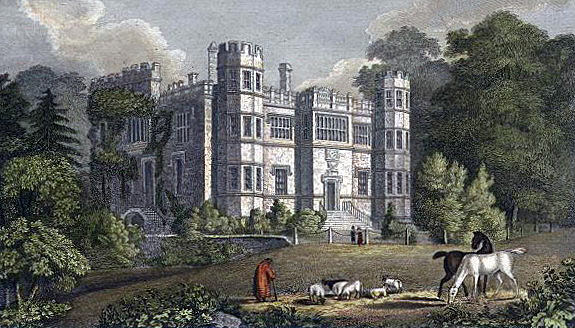The surprise attack on the town of Wakefield in West Yorkshire by Sir Thomas Fairfax on 20th May 1643
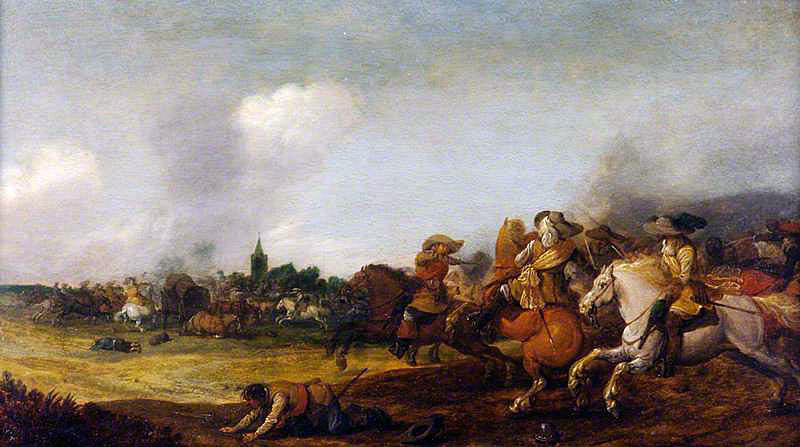
Scene of battle: Battle of Wakefield 20th May 1643 in the English Civil War: picture by Palamedes Palamedesz
The previous battle in the English Civil War is the Battle of Stratton
The next battle in the English Civil War is the Battle of Chalgrove
To the English Civil War index
Battle: Wakefield 1643
War: English Civil War
Date of the Battle of Wakefield: 20th May 1643
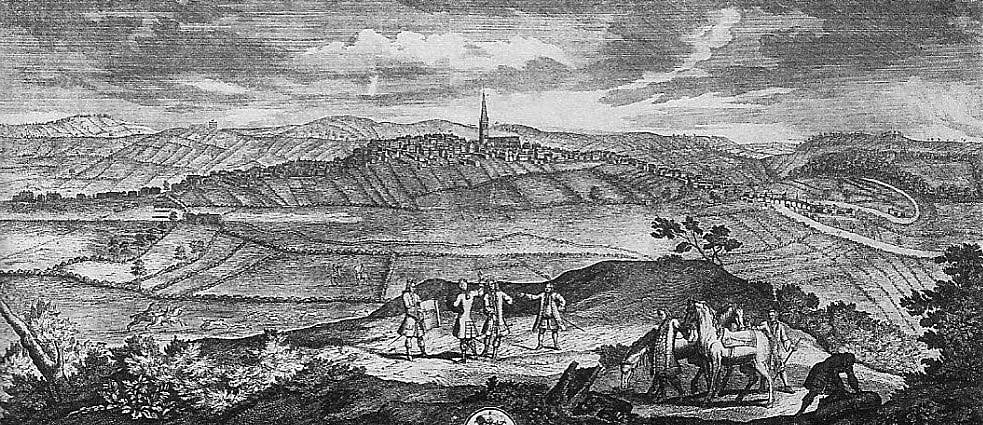
Wakefield from the south: Howley Hall to left background: Heath House to the right: Stanley Village in central distance: all unseen: Battle of Wakefield 20th May 1643 in the English Civil War
Place of the Battle of Wakefield: Wakefield in West Yorkshire.
Combatants at the Battle of Wakefield:
The forces of King Charles I against the forces of Parliament.
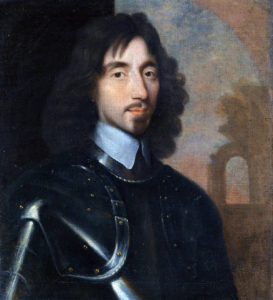
Sir Thomas Fairfax Parliamentary commander at the Battle of Wakefield 20th May 1643 in the English Civil War
Generals at the Battle of Wakefield:
Sir Francis Mackworth (the sergeant-major-general of the Foot in the Earl of Newcastle’s Northern Royalist Army) and General George Goring (the general of Horse in the Earl of Newcastle’s Northern Royalist Army) commanded the force of Royalist Horse, Foot and guns in Wakefield.
Sergeant-Major General Gifford and Sir Thomas Fairfax commanded the Parliamentary contingent of Foot and Horse.
Size of the armies at the Battle of Wakefield:
The Royalist force in Wakefield is reported by Sir Thomas Fairfax as comprising 7 troops of Horse or around 500 Horse and around 3,000 Foot with 4 guns. This figure did not include Colonel Sir William Lampton’s Royalist Regiment reported as entering Wakefield after the attack was launched.
A regiment identified as part of the Royalist army was Sir George Wentworth’s Regiment of Foot.
The Parliamentary army comprised some 8 troops of Horse (500 men), 3 companies of Dragoons (300 men) and 1,000 Foot.
Winner of the Battle of Wakefield: Wakefield was a resounding success for Parliament.
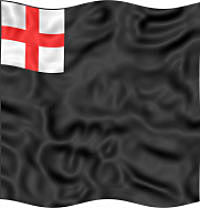
Colour of Sir William Lampton’s Royalist Regiment of Foot: Battle of Wakefield 20th May 1643 in the English Civil War
Uniforms, arms and equipment at the Battle of Wakefield:
See this section in the Battle of Edgehill.
Background to the Battle of Wakefield:
The origins of the English Civil War are dealt with under this section in the Battle of Edgehill.
Reasons for the Parliamentary attack on Wakefield on Whit Sunday 1643:
Different reasons are given for the Parliamentary attack on the town of Wakefield.
One reason is that after the disaster of the Battle of Seacroft Moor Lord Fairfax the Parliamentary commander in Yorkshire was subjected to pressure from the families to obtain the release of the 800 to 1,000 Parliamentary soldiers captured by the Royalists at Seacroft Moor, many of them from the Bradford area.
It is likely that the Parliamentary prisoners from Seacroft Moor were incorporated into the Royalist Army as was frequently the practice with prisoners during the English Civil War. The Parliamentary prisoners would have been dispersed among the Royalist regiments, many of them not in Wakefield. It is hard to see that the attack was launched on such a speculative basis even though claimed by Sir Thomas Fairfax in his report to Parliament on the battle.
A more likely reason is that the commander of the Royalist Northern Army the Earl of Newcastle in planning his attack on the West Yorkshire wool town of Bradford had moved his reserve ammunition supply to Wakefield in anticipation of his advance on Bradford. This ammunition supply consisted of barrels of gunpowder. It was left to the musketeers to cast their own lead bullets.
Each side worked spies in the opposition’s territory and it will have been known to the Parliamentary command that the Royalist ammunition was in Wakefield. Its capture would significantly reduce the fighting capacity of the Royalist army and increase that of Parliament.
Preparing the Parliamentary attack on Wakefield:
As Wakefield was being used as a springboard for the Royalist advance on Bradford the Royalist troops made little effort to fortify the town against any Parliamentary attack.
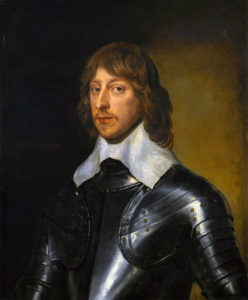
General George Goring Royalist commander: Battle of Wakefield 20th May 1643 in the English Civil War
Sir Thomas Fairfax resolved to mount a surprise attack on the Royalists in Wakefield either to secure the release of the Bradford men captured at the Battle of Seacroft, to obtain prisoners to be exchanged for the Bradford men or more likely to capture the Royalist ammunition reserve.
If the report of the Reverend Nathaniel Johnstone (see below) is correct it came to Sir Thomas Fairfax’s notice that on Saturday 19th May 1643 the officers of the Royalist force in Wakefield were to attend a ‘bowling’ at Heath House. The occasion would involve drinking through the afternoon and night with bowls played on the lawn at the back of the house. Heath House is situated two miles to the east of Wakefield on the far side of the River Calder from the town; the quickest route being via the Wakefield Bridge to the south of the town.
It was resolved that Sir Thomas Fairfax would mount the raid on Wakefield in the early hours of Whit Sunday 20th May 1643.
In the expectation that the Royalist force in Wakefield amounted to around 900 men Sir Thomas Fairfax assembled a force of some 500 Horse and Dragoons and 1,000 Foot from the Parliamentary garrisons in Leeds, Bradford, Halifax and Howley Hall.
In his report of the battle Sir Thomas Fairfax stated that it came as a considerable surprise to him and his men that when the attack was launched the number of Royalist troops in Wakefield turned out to be around 500 Horse and 3,000 Foot with 4 guns.
Account of the Battle of Wakefield:
Sir Thomas Fairfax assembled his Parliamentary force for the attack on Wakefield at midnight at Howley Hall; a large country house in the countryside some seven miles to the north-west of Wakefield occupied by a Parliamentarian supporter Sir John Savile of Lupset and garrisoned by Parliamentary troops.
The Horse were formed into two commands, four troops under Sir Thomas Fairfax and four troops under Sir Henry Foulis. The Foot were commanded by Major-General Gifford and Sir William Fairfax, Sir Thomas Fairfax’s cousin.
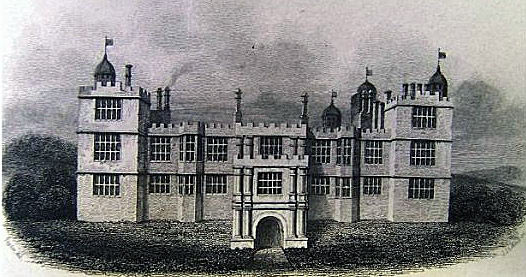
Howley Hall: Parliamentary rendez-vous for the attack on Wakefield: Battle of Wakefield 20th May 1643 in the English Civil War
At 2am Sir Thomas Fairfax’s force marched out from Howley Hall to the south-east heading along the road to the north of Wakefield.
At 4am the Parliamentary force reached the village of Stanley 3 ½ miles east-north-east of Wakefield. A Royalist picket of two troops of Horse and some Dragoons in Stanley village was attacked and 21 prisoners taken.
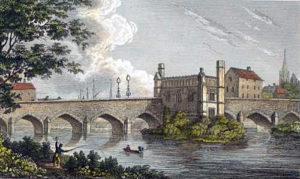
Bridge over the River Calder at Wakefield: Battle of Wakefield 20th May 1643 in the English Civil War
By this time the Royalist troops in Wakefield were aware of the approach of a strong Parliamentary force. The difficulty for the Royalists was that ‘most of the officers and the governor (Sir Francis Mackworth)’ were at the all-night bowls party at Heath House on the far side of the River Calder, from where it will have taken perhaps half an hour for the officers to be recalled, most incapable of performing any useful duty through drunkenness.
Royalist musketeers of the Foot and Dragoons took up positions along the hedgerows outside Wakefield and barricades were hurriedly built across the main streets.
Sir Thomas Fairfax’s Parliamentary force advanced on Wakefield down the northern road from Oulton.
The Royalist musketeers were driven back into Wakefield and assaults were launched on the town, one by way of Northgate and the other by way of Warrengate, the eastern entrance to Wakefield. Sir Henry Foulis and Colonel William Fairfax attacked Northgate while Sir Thomas Fairfax and Sergeant-Major-General Gifford attacked the Warrengate.
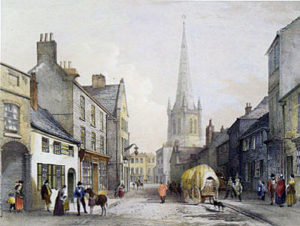
Wakefield Northgate: scene of the Parliamentary attack at the Battle of Wakefield 20th May 1643 in the English Civil War
The attack took an hour and a half at the end of which the barricades were stormed in the teeth of Royalist musket and cannon fire and the Royalists driven back into the centre of Wakefield. The Parliamentary troops captured a Royalist cannon and turned it on the garrison.
With the demolition of the barricades Sir Thomas Fairfax and Sir Henry Foulis charged with their troops of Horse clearing the streets of Royalists. General George Goring, back from the bowling party at Heath House led a furious counter-attack which led to his own capture.
The Royalist Horse were pursued into the Market Square by Sir Thomas Fairfax who finding himself alone was forced to put his horse at one of the barricades to rejoin his men.
In the market place the Parliamentary attackers found three troops of Royalist Horse and Colonel Lampton’s Regiment of Foot drawn up. General Gifford sent forward a trumpeter to offer these men quarter if they would lay down their arms and surrender. This offer was rejected.
Gifford opened fire with the captured cannon and the Parliamentary Horse charged the Royalist troops and drove them out of Wakefield in confusion. The battle was over by 9am.
Once he had mastered Wakefield Sir Thomas Fairfax did not linger in the town, leaving later in the morning with a substantial haul of Royalist prisoners and the Royalist ammunition, returning to the Parliamentary lines.
Casualties at the Battle of Wakefield:
In the Battle of Wakefield, the Parliamentary troops captured from the Royalists 27 colours of Foot, 3 standards of Horse, General Goring, 3 lieutenant-colonels (including Sir Thomas Bland, lieutenant-colonel to Sir George Wentworth’s regiment), 1 major, 11 captains, 5 lieutenants, 15 ensigns and around 1,500 soldiers. 1 major and 1 captain, both wounded were left in Wakefield after giving their parole as prisoners.
Also taken were 4 Royalist cannon and the ammunition reserve of the Earl of Newcastle’s Royalist Army of the North.
Sir Francis Mackworth (the sergeant-major-general of the Foot in the Earl of Newcastle’s Northern Royalist Army) escaped from Wakefield.
Sir Thomas Fairfax in his report of the battle to Parliament claimed that he had lost 7 men killed: a clerk of the stores, an ensign of the Foot, a quartermaster of Horse and 4 soldiers. An unspecified number of Parliamentary troops were wounded.
Follow-up to the Battle of Wakefield:
On receiving Sir Thomas Fairfax’s report of the battle of Wakefield Parliament in Westminster ordered public thanksgiving to be given on 28th May 1643 in all the churches, chapels and places of worship of London, Westminster, the Borough of Southwark and all places adjacent to London with readings of the letters reporting the success.
Parliament needed good news. However the success at Wakefield only delayed the Royalist advance on Bradford and did not prevent the disaster of the Battle of Adwalton Moor on 30th June 1643.
Anecdotes and traditions from the Battle of Wakefield:
- General Goring was captured by Lieutenant Alured the brother of Captain Alured a Member of Parliament.
- Young and Holmes state that Goring was ill with a fever when the attack on Wakefield took place, but rose from his couch and swiftly mounted a counter-attack. A different angle is put on Royalist preparedness by Dr Nathaniel Johnstone.
- Dr Nathaniel Johnstone a contemporary commentator of the English Civil War states that ‘there was a meeting at Heath Hall, a bowling, and most of the officers and the governor were there, and had spent the afternoon in drinking, and were most drunk when the town was alarmed. It was taken fully by nine o’clock in the morning, and more prisoners were taken than the forces that came against it. It seems probable that Sir Thomas Fairfax had notice of their festivities at Heath, and perceived the advantage which they might afford him.’
- The Royalist officers from the force in Wakefield were bowling and drinking on the afternoon and night of Saturday 19th May 1643 at ‘Heath House’ (later known as ‘Heath Old House’; demolished partly in the 19th Century and finally in the 1920s) owned by Dame Mary Bolles. As a result the majority of the Royalist officers were not at their duty in Wakefield when the Parliamentary attack began in the early morning of 20th May 1643 and when they did return they cannot have been in a fit state to perform their duty. The loss of the battle was perhaps inevitable with the Royalist regiments deprived of the leadership of their officers at least in the initial stages .
- Maps of the period show a bowling green at Heath House.
- On Dame Mary Bolles’ death in 1662 in accordance with her wishes her bedroom was bricked up. Some years later the room was opened. From then on Dame Mary’s ghost is said to have haunted the grounds of the house and moor, particularly the area of a water tower she had built for the use of her house and her tenants. Dame Mary Bolles was made baronet by King James I for her financial contribution to the establishment of the colony of Nova Scotia. Dame Mary was and remains the only woman appointed baronet in her own right.
- It is conceivable, although there is no specific authority to support this, that Dame Mary Bolles was a Parliamentary supporter and arranged the afternoon and night drinking and bowls party for the Royalist officers specifically to enable Sir Thomas Fairfax to mount his attack on Wakefield. Dame Mary Bolles appears not to have been subject to sequestration proceedings by Parliament after the Civil War which might indicate a clandestine support for the Parliamentary side.
References for the Battle of Wakefield:
An Account of the Battle on Wakefield Green by George Tyas
History of the Great Civil War by S.R. Gardiner
The King’s War by C.V. Wedgwood
The English Civil War by Peter Young and Richard Holmes
History of the Great Rebellion by Clarendon
The previous battle in the English Civil War is the Battle of Stratton
The next battle in the English Civil War is the Battle of Chalgrove
To the English Civil War index
